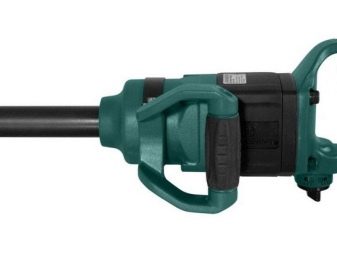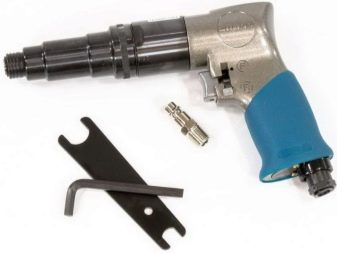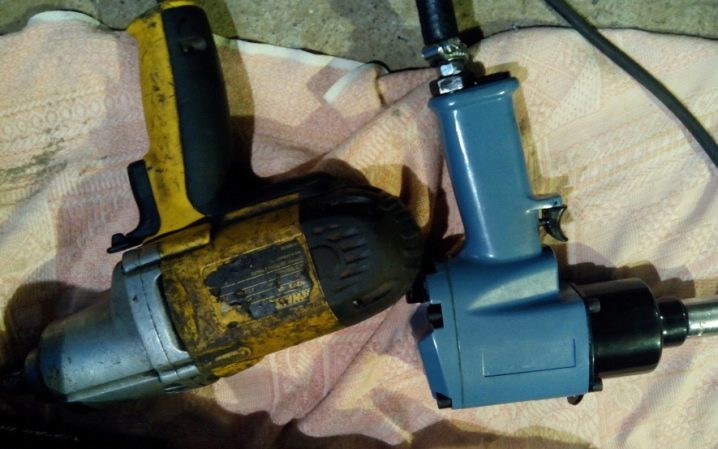Pneumatic wrenches: characteristics and model selection

Pneumatic impact wrenches are a type of tools that work with threaded connections. With their help, you can tighten / unscrew a nut or bolt in any hard-to-reach place in a few seconds.

Purpose and principle of operation
The scope of application of pneumatic impact wrenches (pneumatic torque wrenches) is quite extensive. The devices are successfully used in construction, mechanical engineering, production and in everyday life. The tool can often be found in tire shops and service stations for trucks and cars. The widespread use and demand for devices is due to a simple device, high reliability and an affordable price.


Before considering the principle of operation of the unit, you should refer to its device. So, structurally, the wrench consists of a sturdy ergonomic body, cylindrical or similar to a gun, with a compressor connected to it through a hose. When the trigger is pressed, the rotation mechanism is activated due to the force of the compressed air masses. At the same time, the rotor blades begin to rotate and, through the frame and hammers, transfer their rotation to the stop. In cases where too much force is required to unscrew the nut connection, impact models are used.


Traditional rotation of the stop in such mechanisms does not occur: first, the hammers turn, then they move back a little and engage with the stop. Further, during the second turn, the hammers acquire inertia and at the moment of approaching the engagement they forcefully hit the stop, pushing it in a similar way in the direction of rotation. The blows will be applied until the nut moves from a dead point and the unscrewing process begins.


Thanks to this property, the impact wrench is able to cope with tight hardware, and due to its low weight, it allows you to perform complex work with one hand. Impact models are widely used in vulcanization centers, at enterprises for the repair of agricultural and road equipment, in aviation technical service complexes and in railway workshops for the repair of rolling stock. However, not all models are equipped with an impact mechanism, and simple instruments in which the rotor can only rotate evenly prevail on the shelves.


The change in the direction of rotation of the rotor is carried out by switching the channels for the supply of air masses to its blades. Switching is done by turning the switch knob located on the device body. The material for the manufacture of components and assemblies of the wrench is plastic, composite alloys and metal. Moreover, plastic is used exclusively in its modern versions with the addition of special impurities that increase its strength many times over.


Specifications
The main technical parameters of pneumatic impact wrenches are rotor speed, torque, spindle dimensions and compressor compatibility. Also important is the presence of the reverse and impact mechanism. The reverse device allows you to use the tool not only for dismantling work, but also for assembling various units and assemblies.This function significantly expands the scope of the tool and allows you to rotate the hardware with the same force in both directions.


Impact twist can be used to loosen stuck nuts and bolts. The process does not require the application of special physical efforts of the operator and, due to the presence of a reverse, can be carried out in any direction. Tightening the hardware with a striker does not require a control tightening of the fasteners and is performed in one go. All percussion models have a set of interchangeable heads as standard, designed for any load: the most durable specimens, for the manufacture of which they use hardened steel, are made in a dark color. Medium and light duty heads are available in white.


The material for making extra strong heads is chrome-molybdenum, and those that are weaker are chrome vanadium. In addition to unscrewing stuck nuts, the percussion tool is used to work with large-sized hardware, the diameter of which exceeds 24 mm. This is due to the fact that when tightening such nuts with a non-impact wrench, at the end of the work, they have to be additionally pulled by hand. When using percussion models, manual rework is not required, and the hardware is immediately tightened to the end.

Rotational speed is also an important technical characteristic and determines the overall performance and power of each specific model. Most pneumatic impact wrenches are capable of rotating the rotor at 8000 rpm. There are also more powerful models in which this figure reaches 10 thousand, however, when working with such equipment, a lot of experience and special care are required. This is due to the risk of stripping the threads, which often occurs when tightening small nuts and bolts at high speeds. The rotation speed is controlled by changing the pressure in the compressor unit. However, due to the risk of deteriorating fastener tightening control, you should not get carried away with high speeds.


The torque (tightening force) completely depends on the power of the device and indicates the degree of influence of the twisting force on the hardware. So, at a low torque, threaded connections quickly weaken under the influence of mechanical loads, and at too high values there is a risk of overstressing the thread and its rapid destruction. The maximum tightening torque is possessed by professional nutrunners, in which this figure reaches 5000 Nm. In household models, these values are much lower and range from 30 to 3,000 Nm, while in impact models the torque is not very high and varies from 300 to 2,200 Nm.

The size of the spindle is selected depending on the diameter of the threaded connection with which to work. For example, if you plan to unscrew the nuts with threads up to 25 mm, then the best option would be to use a half-inch spindle. With a diameter of 25-32 mm, an inch size will be required, and for oversized nuts up to 50 mm in size, a one and a half inch spindle will be needed. In addition, some models are equipped with an extended spindle, the size of which can be up to 150 mm, or an additional universal joint, which allows you to work in hard-to-reach places. The above technical parameters are closely related. So, the higher the rotation speed of the model, the stronger its tightening force, the larger the size of its spindle.


Compressor compatibility is also an important technical issue. and has a direct impact on the efficiency of the device and its service life. Compatibility is determined by two parameters: the air flow rate and the maximum pressure that the compressor can provide.The best option is considered to be such a ratio, in which the pressure indicator of the compressor unit exceeds the operating pressure of the pneumatic impact wrench by 2 bar, and the values of its performance exceed the required air flow rate by 1.3 times. If these two conditions are met, then the entire mechanism will work for a long time and trouble-free.


For example, for an pneumatic wrench, which has a working pressure of six atmospheres and an air flow rate of 7.5 liters per second, a compressor unit is required that can create a pressure of 8 atmospheres and has a capacity of at least 9 liters per second. Along with the amount of supplied air, its quality is an important parameter. The pumped air must comply with the parameters stated in the instructions for use and not contain a large amount of water vapor and oils. In order for the quality of the supplied flow to be optimal, a filter system and lubricators are used. Without their work, the wrench will quickly fail and will not be able to serve the term stated in the accompanying documentation.


Views
Today, two types of impact wrenches are produced: straight and pistol angle type.
- Direct models are used only in cases where significant effort is required to loosen or tighten the nuts. The main distinguishing feature of straight models is a powerful tightening force, thanks to which the devices do an excellent job with stuck and old connections. In such models, the axis of rotation of the spindle and the axis of the air motor are the same, which makes it possible with the help of an impact device to obtain a high tightening force of up to 4500 Nm. Straight wrenches are lightweight and are used when working with hardware up to 42 mm in diameter.




- Pistol-type models outwardly resemble a pistol and are equipped with a comfortable handle with control and adjustment buttons located on it. The main feature of this type is a very easy-to-use shape and low weight. Corner models are always equipped with a reversing mechanism, and the average torque is 120 Nm. Russian models are almost always equipped with a percussion device, while foreign models are often equipped with a ratchet mechanism. The main difference between corner models and straight ones is their design. The spindle axis in such devices is located at an angle of 90 degrees relative to the device body, which makes the wrench very compact and allows you to get to hard-to-reach places.




Another criterion for the classification of pneumatic tools is the principle of influence on fasteners. By this criterion, percussive and unstressed models are distinguished. The former, by means of jerky impulses, make it possible to cope with the most complex joints, while the latter are capable of exerting only a smooth forceful effect and are more often used to perform delicate "jewelry" works.


Advantages and disadvantages
Like any other tool, air impact wrenches have both strengths and weaknesses. The advantages include high speed of work, ease of use, convenient ergonomics and low weight. The tool is very easy to operate, and even with a large amount of work, hands practically do not get tired. In addition, unlike an electric tool, pneumatics are completely independent of electricity, so they can be used away from outlets and other power sources.

The disadvantages of pneumatic impact wrenches include the need to purchase a compressor unit and the associated difficulties in organizing a workplace. There is also a rapid failure of consumables: adapters, fittings and seals. This is due to the high intensity of the load on the connection parts, which is why they quickly deteriorate and require replacement.
Popular models
The rating of popular manufacturers of pneumatic impact wrenches is as follows: in the first place is the impact model from Taiwan Jonnesway Jai-1044K... The device has a working pressure of 6.2 bar, an air flow rate of 119 l / min and a rather high torque (tightening torque) of 780 Nm. The rotation frequency is 7 thousand revolutions per minute, the weight of the product is 2.6 kg.


In second place is a reversible percussion device. Fubag IW720 1/2 100193 made in China. The torque is 720 Nm, the speed is 8000 rpm, the air flow is 226 l / min, and the operating pressure is 6.3 bar. The product weighs 2.8 kg.


And the top three is also closed by a Chinese pneumatic wrench made according to Russian technology. Caliber PGU-16 / 310А00000035265... The tightening force is 310 Nm, the pressure is 6.3 atm, the air consumption is 114 liters per minute, and the weight of the model is 2.3 kg. This impact wrench is one of the most budgetary options on the market today.

How to choose?
Before you start purchasing a pneumatic impact wrench, you need to determine how often and in what area it will be used. So, if the model is needed for occasional work in the garage or in the country, it is better to opt for simpler products and purchase a shockless inexpensive tool. If the device is necessary for daily activities at a service station or in a tire fitting, then it is better to buy a professional device with a set of socket heads, reverse and an impact mechanism.

The next selection criterion is the diameter of the threaded connections with which the device will work. In particular, for minor repairs of passenger cars, a model working with a thread diameter of up to 25 mm is suitable, while for servicing medium-sized cars and buses, a side wrench capable of working with threads up to 32 mm is needed. If it is supposed to repair heavy agricultural or construction equipment, as well as trucks, then in this case you cannot do without a serious model designed for overall threaded connections with a diameter of up to 50 mm.

When choosing a tool, its weight and ergonomic characteristics are of great importance. They have a big impact on the productivity and working conditions of the operator. These characteristics of the device are especially important for people working on the conveyor and during the entire shift do not let go of the nutrunner. For such purposes, you should purchase pistol models that have a comfortable, rubberized grip. However, it should be borne in mind that angular devices are more convenient to work on vertical surfaces, that is, with a horizontal wrench. On the other hand, straight cylindrical models are more convenient to work on horizontal surfaces, while placing the device vertically.

When choosing, you need to pay attention to the availability of additional functions. So, if you plan to unscrew / tighten the nuts in recesses or other hard-to-reach places, then it is better to purchase a model equipped with an extended spindle or an additional cardan. With regard to the weight of products, without exception, all pneumatic wrenches are much lighter than their electrical counterparts. This is due to the absence of an engine inside the case, which is why the weight of the heaviest household unit does not exceed 4 kg. Professional models are somewhat heavier, and the most powerful of them can weigh up to 10 kg. For simple and infrequent work, you can choose a very light device, the weight of which will be 750 g.

Preparing the tool for work
In order for the work with the pneumatic nutrunner to be comfortable and safe, it is necessary to properly prepare it. Before attaching the hose to the wrench, blow it out with a short but strong blow.This will remove accumulated dust and moisture formed during storage from its inner walls. The next step will be air preparation. To do this, check the condition of the filters and, if necessary, clean them. According to the instructions, when constantly working with the tool, the filters should be cleaned at least once a week. In addition, it is necessary to drain the accumulated liquid from the dehumidifier tank every day. In some high-tech models, the liquid drain is automated.

The next prerequisite for preparing the device for operation is its lubrication. To do this, use only specialized oil recommended by the tool manufacturer. Such oil should have a synthetic base, and should not contain silicone components. The main task of lubrication is to prevent the appearance of rust and prevent rapid wear of the contacting parts. You can lubricate the wrench yourself according to the following scheme: 3-5 drops of oil must be dripped into the air inlet, then run the device for half a minute and let the oil be evenly distributed over all the internal parts of the wrench.


It is advisable to lubricate the tool not only before starting work, but also before sending it to storage. With active use, the device should be lubricated every 3-4 hours. This procedure is quite troublesome, therefore, in such cases, the best option would be to install a mini-lubricator - a lubricator. He will supply oil to the device in a timely manner, the main thing is not to forget to replenish it in a timely manner. In addition to lubricating the main units, it is advisable to lubricate the impact mechanism every 50 hours of operation. This will help to avoid malfunctions and prolong the life of the wrench.

When working with the device, it is important to monitor the optimal air pressure. Since exceeding this indicator leads to a quick wear of the moving elements, and a decrease leads to a loss of device power. Therefore, it is recommended to install a pressure regulator equipped with a pressure gauge. Place such a sensor between the pipeline and the hose. For professional equipment, it makes no sense to purchase a filter, lubricator, water separator and pressure regulator separately. It is more expedient to buy and install a filter group that includes all four devices.

Features of operation
When using pneumatic tools there are a few simple rules to follow.
- It is strongly not recommended to use the device near open flames, as well as store it near sources of high temperatures and high humidity.
- The device must be protected from accidental drops, and also try not to expose it to weight, mechanical and vibration loads.
- It is strictly forbidden to increase the recommended working pressure in order to increase the tightening torque. Such actions will entail rapid wear of the main components and disable the device.
- It is highly undesirable to keep the tool under load for a long time. This will quickly wear out the impact mechanism and shorten the service life of the device.

For information on how to choose a pneumatic impact wrench, see the next video.













The comment was sent successfully.